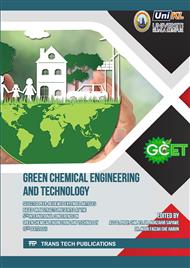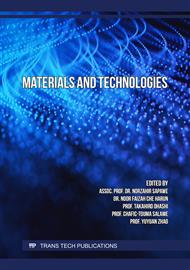[1]
R.M. Sukma, Abd. Gafur, H.H. Abbas, Biokonsentrasi logam berat timbal, arsen pada air dan ikan sungai tallo kota Makassar tahun 2020, WoPHJ. 01 (2020) 304-316.
DOI: 10.33096/woph.v1i4.132
Google Scholar
[2]
P. Novita, S. Yanto, P. Patang, Pengaruh habitat mangrove terhadap penurunan tingkat cemaran timbal di muara sungai tallo, JPTP. 5 (2019) 69-82.
DOI: 10.26858/jptp.v5i0.8560
Google Scholar
[3]
G.A.Y. Dewi, S.A. Samson, Usman, Analisis/kandungan logam berat Pb dan Cd di muara sungai manggar/Balikpapan, J. Ecotrophic. 12 (2018) 122-124.
DOI: 10.24843/ejes.2018.v12.i02.p02
Google Scholar
[4]
M. Osinska, Removal of lead(II), copper(II), cobalt(II) and nickel(II) ions from aqueous solutions using carbon gels, J. Sol-Gel Sci. Technol. 81 (2017) 678–692.
DOI: 10.1007/s10971-016-4256-0
Google Scholar
[5]
D.M. Manohar, B.F. Noeline, T.S. Anirudhan, Adsorption performance of alpillared bentonite clay for the removal of cobalt(II) from aqueous phase, J. App. Clay Sci. 31 (2006) 194-206.
DOI: 10.1016/j.clay.2005.08.008
Google Scholar
[6]
N. Sasria, Fahmiati, Mashuni, Ni2+ adsorption performance/ofximmobilized Saccharomyces/cerevisiae/in fractionated clay from Southeast Sulawesi, J. Phys. Conf. Ser. 1726 (2021) 1-11.
DOI: 10.1088/1742-6596/1726/1/012021
Google Scholar
[7]
I.F. Nucifera, T.A. Zaharah, I. Syahbanu, Uji stabilitas kitosan-kaolin sebagai adsorben logam berat Cu(II) dalam air, Jurnal Kimia Khatulistiwa. 5 (2016) 43-49.
Google Scholar
[8]
Y. Prasetiowati dan T. Koeastiari, Kapasitas adsorpsi bentonit teknis sebagai adsorben Ion Cd2+, UNESA J. Chem. 3 (2014) 194-200.
Google Scholar
[9]
H.A. Patel, R.S. Somani, H.C. Bajaj, R.V. Jasra, Synthesis and characterization of organic bentonite using Gujarat and Rajasthan clays, Curren Sci. 92 (2007) 1004-1009.
Google Scholar
[10]
M.R. Filayati, Rusmini, Pengaruh massa bentonit teraktivasi H2SO4 terhadap daya adsorpsi iodium, UNESA J. Chem. 1 (2012) 59-67.
DOI: 10.26740/icaj.v1n1.p10-17
Google Scholar
[11]
M. Pentrak, V. Hronsky, H. Palkova, P. Uhlik, P. Komadel, J. Madejova, Alteration of fine fraction of bentonite from Kopernica (Slovakia) under acid treatment: a combined XRD, FTIR, MAS NMR and AES study, Appl. Clay Sci. 163 (2018) 204–213.
DOI: 10.1016/j.clay.2018.07.028
Google Scholar
[12]
P. Soleman, Identifikasi gugus fungsi dan kandungan mineral lempung Pacitan dengan spektroskopi infra red (IR) x-ray diffraction (XRD), J. Photon. 2 (2011) 31-35.
DOI: 10.37859/jp.v2i1.124
Google Scholar
[13]
H. Sastrohamidjojo, Spektroskopi Inframerah, Liberty, Yogyakarta, (1992).
Google Scholar
[14]
K.D. Nugrahaningtyas, D.M. Widjonarko, Daryani, Y. Haryanti, Kajian Aktivasi H2SO4 terhadap proses pemilaran Al2O3 pada lempung alam Pacitan, Alchemy J. Penelitian Kimia. 12 (2016) 190–203.
DOI: 10.20961/alchemy.12.2.1312.190-203
Google Scholar
[15]
Nurhasni, F. Firdiyano, Q. Sya'ban, Penyerapan ion aluminium dan besi dalam larutan sodium silikat menggunakan karbon aktif, J. Kimia Valensi. 2 (2012) 516-525.
DOI: 10.15408/jkv.v2i4.269
Google Scholar
[16]
A. Hayuwardini dan B. Mulyani, Pemanfaatan arang ampas tebu (Bagasse) sebagai adsorben larutan campuran ion Pb2+ dan Cu2+, SN-KPK XIII. 13 (2022) 110-120.
Google Scholar
[17]
L. Emelda, S.M. Putri, S.B. Ginting, Pemanfaatan zeolit alam teraktivasi untuk adsorpsi logam Cr3+, J. Rekayasa Kimia dan Lingkungan. 9 (2013) 166-172.
DOI: 10.23955/rkl.v9i4.1229
Google Scholar
[18]
P. Pranoto, T. Martini, D.A. Rachmawati, Karakterisasi dan uji efektivitas allophane-like untuk adsorpsi ion logam tembaga (Cu), ALCHEMY J. Penelitian Kimia. 14 (2018) 202-218.
DOI: 10.20961/alchemy.14.2.18538.202-218
Google Scholar
[19]
K. Beroeh, Pengaruh suhu karbonisasi terhadap daya serap karbon aktif dengan aktivator ZnCl2 dari serbuk gergaji kayu jati, J. Teknik Kimia UMJ. (2004).
DOI: 10.21009/0305020215
Google Scholar



